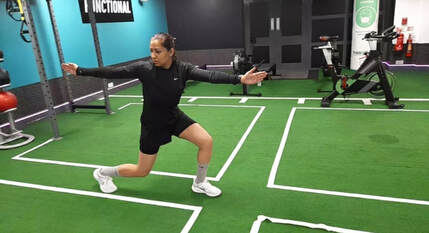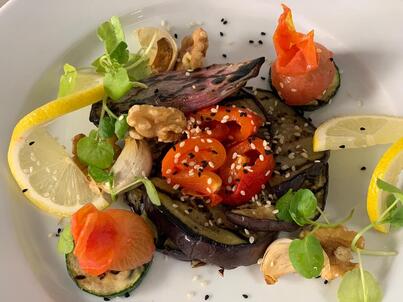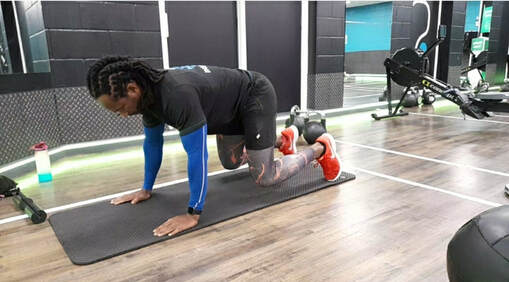 As Temperature sizzle in the UK, exercising in the unaccustomed heat can place extra stress on the body, with the biggest challenge being to avoid overheating, The key to exercising in the heat is to start gradually and allow the body time to gradually adapt to the heat. If you’re going for a 60-minute work, build gradually over the first ten minutes so that your thermoregulatory system has time to adjust to the simultaneous stresses of the heat and exercise so you would want to start with you’re less intense exercise. 1. HYDRATE, HYDRATE, HYDRATE Your body will lose more fluid while exercising in hot conditions and if you remain dehydrated for your next exercise session, it’ll negatively impact your performance. Replenish the body with cold fluids (water, not wine!) and ensure that your urine is clear (not yellow) two or three hours after the session. 2. GET PLENTY OF SLEEP Exercising in the heat will be more stressful on many of your physiological systems – and getting at least seven hours of sleep is even more important to allow the body to repair and revive. If possible, sleep in a cool room (17-20°C) but don’t run an air conditioner or fan, as dry air can further exacerbate dehydration overnight. 3. CHOOSE A SUITABLE ACTIVE RECOVERY FOR THE HEAT You might normally choose to cycle, swim or walk to recover from your workout but in the heat, it’s important to choose something light and easy – and out of the heat. Lido or wild swimming are great shouts if you live near a suitable body of water. 4. PLAN HOW YOU’RE GOING TO COOL DOWN You’ve plotted your route or booked your class, you’ve packed your bags – now you need to plan how you’ll cool down ASAP after moving. A cool shower or fan is a great strategy, as is having a wet towel on the back, neck and/or wrists. 5. WASH THE SWEAT OFF YOUR SKIN AS SOON AS POSSIBLE You’ll sweat more in the heat and while sweating might be great for skin health in general, the sodium (salt) in the sweat can cause skin dehydration. The ammonia and urea that are naturally present in sweat can also cause irritation and inflammation, so wipe down or shower as soon as you 6. REFUEL WITH HEALTHY FOOD OR FLUIDS You might feel less hungry than usual when it’s hot, even after exercising. Getting in some protein and carbohydrates soon after your session can be harder than usual so try cool smoothies or ice-loaded protein shakes to top up your nutrient and fluid intake.
1 Comment
 Foods and drinks provide our body with energy in the form of carbohydrates, fat, protein and alcohol. Carbohydrates are the body’s preferred energy source. The glycaemic index (GI) is a way that carbohydrates in foods and drinks are ranked according to how quickly they raise the glucose level of the blood (also known as ‘blood sugar level’). It has replaced classifying carbohydrates as either ‘simple’ or ‘complex’. Foods with carbohydrates include bread, breakfast cereals, rice, pasta, legumes, corn, potato, fruit, milk, yoghurt, sugar, biscuits, cakes and lollies. Digesting and absorbing carbohydrates The digestive system breaks down carbohydrates in foods and drinks into simple sugars, mainly glucose. For example, both rice and soft drink will be broken down to simple sugars in your digestive system. This simple sugar is then carried to your body’s cells through the bloodstream. The pancreas secretes a hormone called insulin, which helps the glucose to move from your blood into the cells. Once inside a cell, the glucose is ‘burned’ along with oxygen to produce energy. Our brain, muscles and nervous system all rely on glucose as their main fuel to make energy. The body converts excess glucose from food into glycogen. Glycogen acts as a storage form of glucose within the muscle tissue and the liver. Its role is to supplement blood glucose levels if they drop between meals (especially overnight) or during physical activity. The glycaemic index (GI)The glycaemic index (GI) is a way of ranking carbohydrate-containing foods based on how slowly or quickly they are digested and increase blood glucose levels over a period of time – usually two hours. The GI uses glucose or white bread as a reference food – it has a GI score of 100. Carbohydrate-containing foods are then compared with this reference to assign their GI. This ensures all foods compared have the same amount of carbohydrate, gram for gram. Carbohydrates that break down quickly during digestion have a higher glycaemic index. These high GI carbohydrates, such as a baked potato, release their glucose into the blood quickly. Carbohydrates that break down slowly, such as oats, release glucose gradually into the bloodstream. They have low glycaemic indexes. The blood glucose response is slower and flatter. Low GI foods prolong digestion due to their slow breakdown and may help with feeling full. GI scale examples The terms ‘low GI’, ‘medium GI’ and ‘high GI’ are given to foods that fall within different ranges of the GI. These ranges, along with some example foods, include:
Generally, eating low GI foods and high GI foods at the same time has the effect of ‘averaging’ the GI. This is important, as most foods are eaten as part of a meal and this affects the GI value of foods. For example, eating cornflakes (a higher GI food) with milk (a lower GI food) will reduce the overall effect of the cornflakes and milk meal on blood glucose levels. GI and exercise Eating low GI foods two hours before endurance events, such as long-distance running, may improve exercise capacity. It’s thought that the meal will have left your stomach before you start the event, but remains in your small intestine releasing energy for a few hours afterwards. Moderate to high GI foods may be most beneficial during the first 24 hours of recovery after an event to rapidly replenish muscle fuel stores (glycogen). Choosing between high and low GI foods The best carbohydrate food to eat varies depending on the person and situation. For example, people with type 2 diabetes or impaired glucose tolerance have become resistant to the action of insulin or cannot produce insulin rapidly enough to match the release of glucose into the blood after eating carbohydrate-containing foods. This means their blood glucose levels may rise above the level considered optimal. Now consider two common breakfast foods – cornflakes and porridge made from wholegrain oats. The rate at which porridge and cornflakes are broken down to glucose is different. Porridge is digested to simple sugars much more slowly than cornflakes, so the body has a chance to respond with production of insulin, and the rise in blood glucose levels is less. For this reason, porridge is a better choice of breakfast cereal than cornflakes for people with type 2 diabetes. It will also provide more sustained energy for people without diabetes. On the other hand, high GI foods can be beneficial at replenishing glycogen in the muscles after strenuous exercise. High GI can also quickly restore blood glucose levels to normal when someone with diabetes is experiencing a ‘hypo’, which is when their blood glucose levels fall below the normal range of 4–8 mmol/L. For example, eating five jellybeans will help to raise blood glucose levels quickly. A person with diabetes is only at risk of a ‘hypo’ if taking certain medications or injecting insulin. If you have a medical condition, such as diabetes, it’s important to get advice from your doctor or specialist before making any changes to your diet.  Adopting small changes over time can add up to better health in the long term. Focus on building your core strength by adding one simple exercise to your weekly exercise plan — the plank. The plank position, which looks like the high part of a push-up, works your core muscles, which are the major muscles in the area that connects your upper and lower body. These include the abdominal muscles and those in the back, sides, hips, and buttocks. The core also encompasses the muscles in your pelvis, including those that help support your bladder, uterus, and other internal organs. Test yourself First, can you hold a plank? Try the plank with your arms extended or resting on your elbows. Be certain to keep your back straight and your head in a neutral position looking at the ground. If you can't hold the position, modify the exercise by resting your weight on your knees instead of your feet (sometimes referred to as a modified push-up position). Whatever version you do, time yourself to see how long you can hold the position. Then repeat the exercise a few times a week, or even daily. Try to gradually increase the number of planks you do or the amount of time you stay in a plank (or modified plank position) over time. Start with one plank a day and build from there and increase your plank hold time gradually. "If you can hold it for three seconds, try it for four. If you can hold it for four, try to get to 10 seconds. The goal is to be able to hold your plank for a full minute. "There's a saying that when you can hold a plank for a minute, your back pain will be gone. Planks may ease back pain because as your core muscles strengthen, they provide more support for your spine. Having a stronger core can also help you move more easily and make your movements more stable. Modified front plank on knees
Starting position: Kneel on all fours with your hands and knees directly aligned under your shoulders and hips. Movement: Tighten your abdominal muscles and walk your hands forward. Lower your upper body onto your forearms and drop your hips so your body is in line from your head to your knees, like a plank. Clasp your hands and align your shoulders directly over your elbows. Hold. This is one rep. Aim to hold for a total of 60 seconds, doing as many reps as needed to reach that total. For example, if you can hold a plank for 15 seconds, you would do four reps. Front plank
Starting position: Kneel on all fours with your hands and knees directly aligned under your shoulders and hips. Movement: Tighten your abdominal muscles and lower your upper body onto your forearms, clasping your hands together and aligning your shoulders directly over your elbows. Extend both legs with your feet flexed and toes touching the floor so that you balance your body in a line like a plank. Hold. This is one rep. Aim to hold for a total of 60 seconds, doing as many reps as needed to reach that total. For example, if you can hold a plank for 15 seconds, you would do four rep  Results from a 2017–2018 W.H.O Survey found that about 73% of all adults in the world are classified as overweight or obese. Excess weight increases your risk of heart disease, diabetes, and some types of cancer. But it also affects your daily life. "When you carry around extra pounds, you can have trouble staying active, low energy, and difficulty sleeping. Personal issues also can affect weight gain by making you eat more and exercise less. "Family discord, work situations, economic problems, the recent death of loved ones, and anything else that causes stress can contribute to weight gain," I would suggests trying to identify elements in your life that may sabotage your weight-loss efforts and focus on how to address them. "You should consider that weight gain is sometimes a symptom of an underlying problem. Issues that weigh you down Many factors contribute to weight gain. The obvious ones are poor diet and lack of exercise. But age is also an issue. As you get older, it’s easier to gain weight and tougher to lose it. Why? Lean muscle mass steadily declines over the years, and the change becomes more noticeable after age 40. "Muscles burn calories 24/7. If you have less muscle, your body burns fewer calories, which can lead to easier weight gain," Weight Is Easy To Gain Many factors contribute to weight gain. The obvious ones are poor diet and lack of exercise. But age is also an issue. As you get older, it’s easier to gain weight and tougher to lose it. Why? Lean muscle mass steadily declines over the years, and the change becomes more noticeable after age 40. "Muscles burn calories 24/7. If you have less muscle, your body burns fewer calories, which can lead to easier weight gain," A man’s ideal weight is usually about the amount he weighed at age 20, according to Dr. Willett. Can’t remember that far back? There are other ways to assess whether your weight poses a health risk. Body mass index (BMI) is a measurement that considers both height and weight. Your BMI number indicates whether you are underweight, normal weight, overweight, or obese. However, BMI alone is not always a good indicator of what’s happening to your body. "Your BMI might remain relatively stable because you have more body fat and less muscle mass," says. "Still, BMI can offer a clue about whether you need to lose excess weight." Waist size is another way to gauge weight gain but focus on how snug your pants feel rather than whether you moved your belt notch. "You can often feel weight gain before you can see it," Even if you are not technically overweight just yet, don’t wait to act. "A seemingly innocent five added pounds still can have some adverse effects on your health. "But the greater threat is that it suggests you are on a trajectory toward bigger problems." The 5% solution To be successful with weight loss, you also need realistic expectations. "A slow reduction is better than a quick reduction over a few weeks, which you probably can’t maintain Aim to lose a half-pound to a pound per week until you’ve lost 5% of your current weight. "Even with this modest loss, people should feel successful as this will reduce some health risks, especially for heart disease, If you want to continue, focus on another 5%, reassess, and go from there. "The main goal is to find a way toward a pattern of healthy eating and activity that you can maintain, not to simply maximize weight loss." Carbs and calories No surprise: diet and exercise are still the best tag-team approach to weight loss. For diet, focus on limiting unhealthy carbs and excess calories. Research has shown that reducing carbs, especially sugar and refined starches, makes the body burn more fat for energy. A few small diet changes can help curb your carb intake. First, take a close look at which beverages you drink, like juices, sodas, and other sweetened beverages, and how much. "Many unhealthy simple carbohydrates are liquids, which are often high in calories,". "We often don’t register those calories compared with food, so it’s easy to overindulge. Simply eliminating sugary beverages from your diet is a great way to jump-start your weight loss." Next, switch out refined grains (white rice, white bread, pasta) for whole grains (whole-wheat pasta, brown rice, oatmeal). Whole grains, especially if they don’t get ground into fine flour, are more slowly digested, which keeps blood sugar levels from spiking. They also have more fibre, various essential nutrients, and phytochemicals. In terms of calories, focus on not overeating during meals. You can do this by monitoring portion size and eating habits. For example: Change your tableware. Switch to a smaller bowl or a mug for cereal and a smaller dinner plate. Use measuring cups. Measure out servings of the foods you commonly eat. Don’t eat while watching TV. The distraction tricks you into overeating. But diet is only half of the battle. You also must stay active to burn enough calories and help build calorie-burning muscle mass. It doesn’t really matter what exercise you do. "Consistency is key,". "Begin by choosing activities that you enjoy and do them for at least 3 hours each week." Also, include at least two sessions of strength and high intensity training per week to help build lean muscle mass. |
AuthorsThis blog is updated by Tranquillity 360 fitness personal trainers, as well as other guest bloggers. Archives
July 2021
Categories |

 RSS Feed
RSS Feed